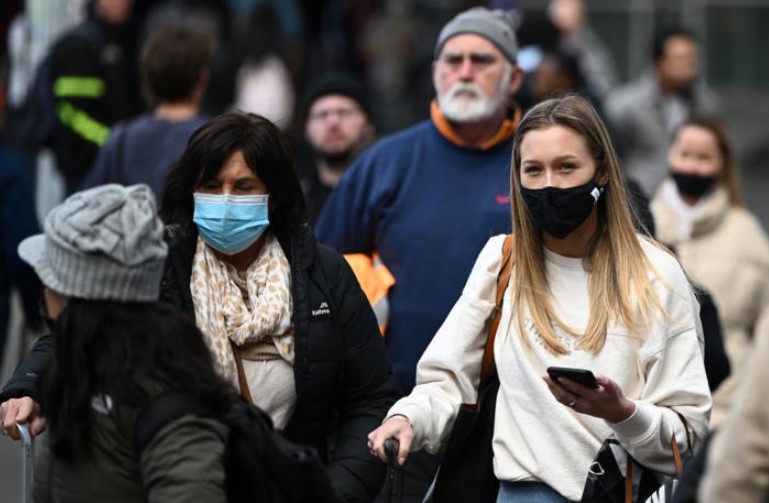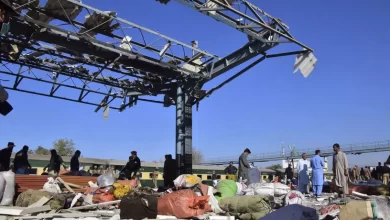Australia Covid cases rising but peak before Christmas still predicted

Covid cases are continuing to rise across Australia, but health authorities remain confident the peak will hit before Christmas.
Cases have more than doubled in New South Wales and Victoria compared with the beginning of November, and jumped by 20% in the space of a week. The numbers build on the increases recorded last week of 10-15%.
But they are climbing at a slower rate than earlier in November, when cases in NSW and Victoria were doubling in just a fortnight, driven by a “soup” of Omicron subvariants.
NSW recorded 37,796 new Covid cases in the week to 1 December, a 19% increase compared with the previous week’s 31,531.
Victoria recorded 26,971 new cases in the latest weekly reporting period, a 21% increase on the previous week’s 22,281.
Related: More than 33,000 Covid fines withdrawn in NSW after adverse court ruling
No single variant is dominant in the community as the BA.2 and BA.5 sub-lineages continue to drive transmission. In NSW, 11 Omicron sub-variants and recombinant variants are circulating.
Catherine Bennett, chair in epidemiology at Deakin University, said that in the fourth wave case numbers could reflect changes in testing and reporting practices as well as underlying infection rates, making them harder to interpret.
“Sydney wastewater detections have been on the rise but patchy, with some areas showing a decline,” she said.
“Like overall infection reports, there is still an upward trend but … a tapering of growth, which is reassuring.
“I don’t think we are likely to see a sharp peak in this wave, with numbers suddenly dropping. The mix of variants that are circulating makes that less likely for us as this lifts the likelihood of reinfection.”
Deaths, which are usually a lagging indicator on cases, remain relatively stable.
NSW recorded 32 deaths in the past week, an increase of seven compared with the previous reporting period. Twelve deaths were in aged care residents, including 10 who died in a facility.
There were 1,481 people being treated in hospital with the virus, including 38 people in intensive care, as the seven-day rolling average of daily admissions decreased to 87, compared with 89 the previous week.
Health authorities said hospitalisations and ICU admissions had fallen, but the rise in Covid cases and positive PCR tests indicated “ongoing high levels of transmission in the community”.
PCR testing increased by 8.9% compared to the previous week, with the highest notification rates for people over the age of 80. About 19% of tests returned a positive result.
But rates of testing had almost halved from the beginning of the Omicron wave in winter.
The one outlier was emergency department presentations, which continued to increase week-on-week. There were 374 admissions with Covid in the latest reporting period, an increase of 53 compared with the previous week’s 321.
James Wood, an associate professor of epidemiological modelling of infectious diseases at the University of New South Wales, said he still expected cases to peak before mid-December in NSW with a “lower but broader wave” than that experienced in Singapore, a country with similar vaccination rates.
“Reported cases are still only at about the inter-wave level we saw between BA.1 and BA.2 and then between BA.2 and BA.5, so it’s still substantially lower than what we’ve seen previously,” he said.
“It’s good news that we’ve seen a decline in hospitalisations but I’m not completely sold that they have peaked yet in NSW.”
Victoria recorded 54 deaths in the past week, a jump on 68 deaths in the previous reporting period.
An average of 550 people were being admitted to hospital with the virus each day, including 21 people requiring intensive care, an increase on 430 hospitalisations and 15 daily admissions the week prior.
Bennett said Omicron sub-variants had a potential transmission rate of eight or more – meaning every infectious person may infect around eight people – and Australia was “nowhere near that”.
“Thankfully, we are closer to 1.1,” she said.
While hospital admissions have increased in Victoria, Bennett cautioned the figures also included a mix of incidental infections – meaning people who may have been admitted for other reasons happened to test positive for the virus.
“The big admissions to ICU have stopped,” she said.
“As total hospital number is cumulative – a person is counted for as long as they are there. This number should show a decline next week as discharges are replaced by fewer admissions.”
Victoria’s latest wastewater testing results found a strong detection of Sars-CoV-2 – the virus that causes Covid – in every geographical area, and a continued “very strong” detection in Craigieburn.
Similarly, all tested samples in NSW contained fragments of Sars-CoV-2, with a particular increase in Liverpool and Wollongong and a stabilisation in Bondi and Quakers Hill.
Queensland recorded 11,217 new cases in the week ending 30 November, an 11% increase on 10,82 in the previous reporting period.
Hospitalisations stayed relatively stable, with 320 compared with 312 last week, including eight people in intensive care. There were 15 further deaths.
Tony Blakely, a University of Melbourne epidemiologist, said Australia was in a “difference space” to a year ago, with high rates of past infection and vaccination creating a “hybrid immunity” despite the capacity for new infections to partially escape immunity.
“A black swan event of a new variant with both high escape and high virulence aside, we are in the grumbling finishing stages of the pandemic where we settle into the new norm,” he said.
“We still don’t know what it is, but we suspect it will be ongoing smaller waves for many years, possibly decades.”







